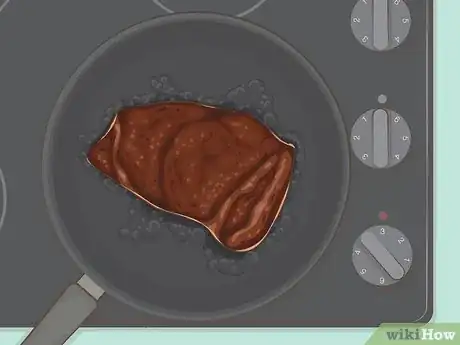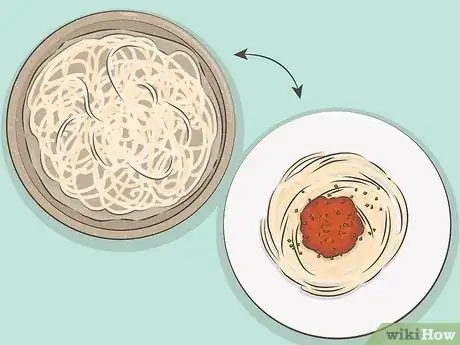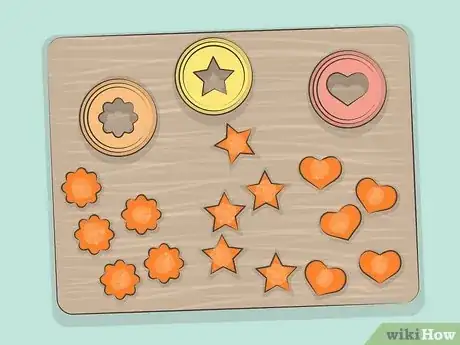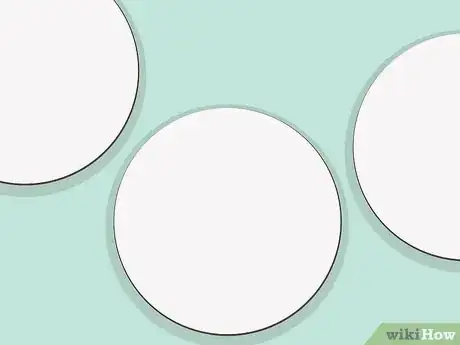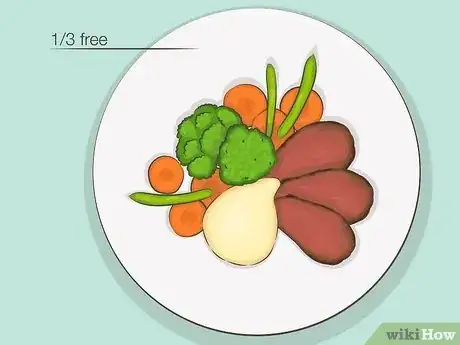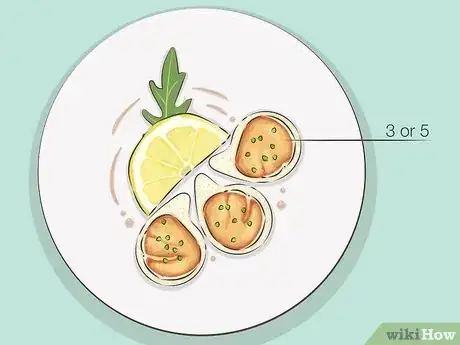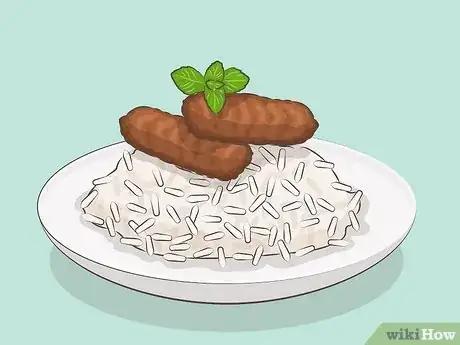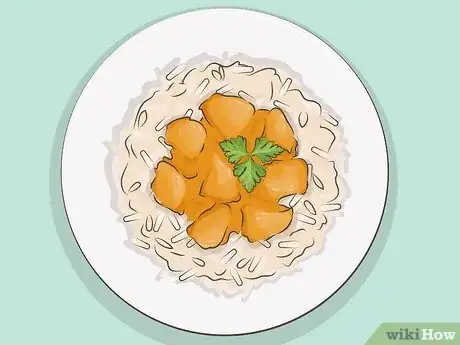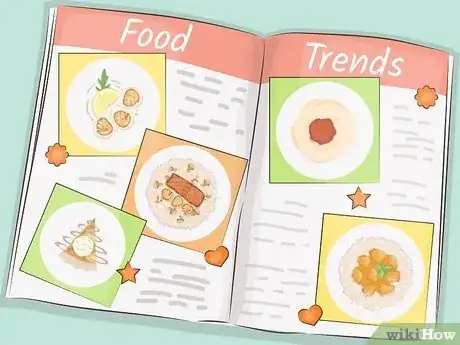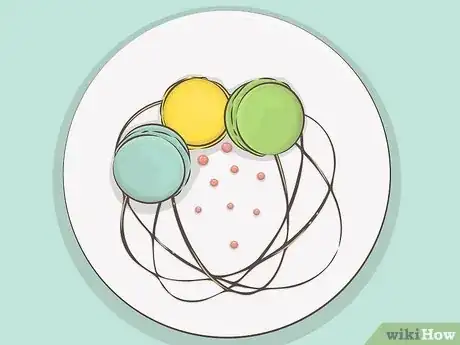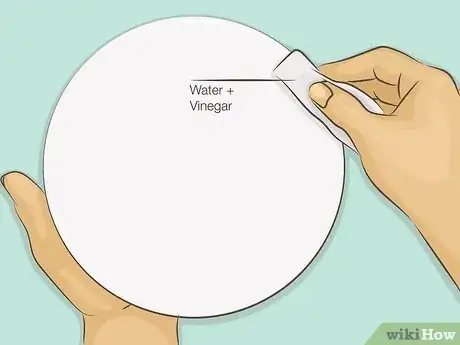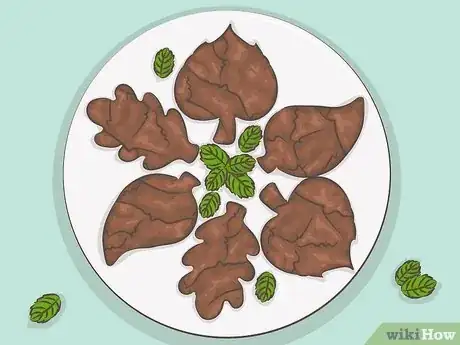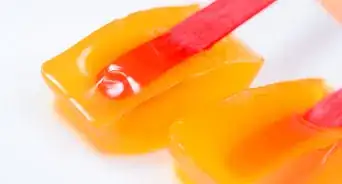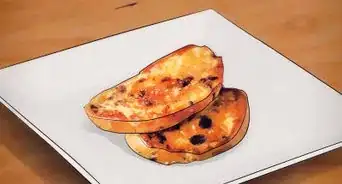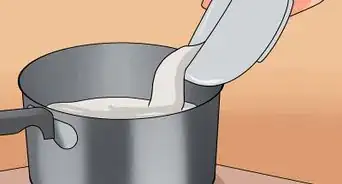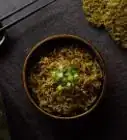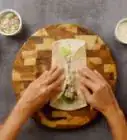This article was co-authored by JoAnna Minneci. JoAnna Minneci is a Professional Chef based in the Nashville, Tennessee area. With more than 18 years of experience, Chef JoAnna specializes in teaching others how to cook through private cooking lessons, team-building events, and wellness and nutrition classes. She has also appeared in numerous television shows on networks such as Bravo and Food Network. Chef JoAnna received Culinary Arts training from the Art Institute of California at Los Angeles. She is also certified in sanitation, nutrition, kitchen management, and cost control.
There are 19 references cited in this article, which can be found at the bottom of the page.
wikiHow marks an article as reader-approved once it receives enough positive feedback. In this case, several readers have written to tell us that this article was helpful to them, earning it our reader-approved status.
This article has been viewed 594,390 times.
When you're plating food, your goal should be to make the food look attractive and appetizing. This is because people eat with their eyes first, so if the food looks good, they're more likely to enjoy it.[1] To achieve restaurant-quality presentation, layer the food and experiment with contrasting colors and textures to make it as appealing as possible.
Steps
Starting With Beautiful Food
-
1Avoid a monochromatic color scheme. A plate of food looks most appealing when there's a high level of contrast in colors. Imagine being served a bowl of plain oatmeal or a dish of pasta without any sauce. Even if the oatmeal or pasta has been dressed with flavorful ingredients like butter and spices, it looks like a plain dish of starch. Serve the same bowl of oatmeal with fresh red berries and a swirl of amber maple syrup, or plate the pasta with a healthy drizzle of green pesto and chopped cherry tomatoes, and you've created a wholly different dining experience. No matter what you're serving, think of ways to add more color contrast.[2]
- When you're planning meals, think ahead about the colors you want to feature on the plate. You might not be able to represent all the colors of the rainbow at every meal, but challenge yourself to have as much color as possible.
- If you realize you're about to serve several like-colored foods, like grilled chicken and mashed potatoes, adding a serving or two of fruits and vegetables is a fantastic and easy way to add pops of color. The richest greens, oranges, reds, purples, blues, pinks, and yellows on your plate probably take the form of fruits and vegetables.
- If you're not sure how to add color, utilize garnishes.[3] Nearly any savory dish is well-served by a sprinkling of fresh chives, parsley, dill, or mint. Lemon and lime wedges are welcome alongside poultry and seafood dishes.
-
2Bring out vegetables' brightest colors. The way you cook your vegetables has a lot of bearing on the overall visual effect of a meal. Veggies that are a tad overcooked lose their color and tend to look less appetizing than those that are cooked just to the point of softness. To avoid mushy, pallid vegetables, aim to cook them until they're bright with a bit of crunch. Here are a few ways to bring out the best in your vegetables:
- Lightly steam them instead of boiling them.[4] Steaming vegetables makes them look appetizing and flavorful, while boiling creates the opposite effect.[5] Take broccoli, for instance: steaming broccoli turns it a fresh, bright green, and each floret retains its shape and texture. Boiling broccoli results in a mushy texture and a paler color, which isn't as pretty on the plate. The same holds true for asparagus, carrots, green beans, and many other vegetables.
- Roast or sauté them with a little oil or butter. Roasted or sauteed vegetables look quite appetizing when they're allowed to caramelize a little in oil or butter. The bright orange or green of the vegetable is offset by brown, crispy spots. It's a delicious way to cook vegetables.
Advertisement -
3Sear your meat and let it rest.[6] Many meat dishes look most appetizing when the meat has been seared. The sight of a steak or piece of grilled salmon with a brown, crispy sear will make your dinner guests' mouths start to water. In addition to searing your meat, you should let it rest for several minutes before cutting it. This allows the juices to absorb back into the meat so that they don't end up running all over the plate.
- There are exceptions to the rule of searing your meat. For example, if you're serving braised beef, you'll have to think of creative ways to make the meat look appetizing even though it doesn't have a crispy crust. Serving it with a sauce is a good way to add visual interest.
-
4Cook fried foods carefully.[7] Underdone or overcooked fried foods are difficult to present in an appealing way. Fried foods can look beautiful on a plate, but it's important to fry them well and have a plan for dealing with the oil so it doesn't muck up the rest of the dish. Cook fried foods until they're golden brown, then let them drain on a plate lined with paper towels to absorb the extra oil. Otherwise, the food will leave streaks of grease on the plates.
- Fried foods often continue browning a bit after they've been removed from the hot oil. Carefully monitor foods as you're frying them to make sure they don't get too dark.
- Take pains to handle the fried foods gently so they look appetizing when you're ready to plate them. For example, if you need to check whether a piece of fried chicken has reached the correct internal temperature, stick the meat thermometer in a place where the resulting hole won't be visible.[8]
-
5Take texture into account. Texture and color go hand in hand when it comes to how appetizing food looks on the plate. If your food looks too oily, too dry, mushy, tough, or otherwise difficult to chew and swallow, it won't matter how perfectly colorful it looks. Take pains to cook food well so that it comes out to the right texture.
- The way you handle the food just after it has been cooked, and before it is plated, can really affect the texture. Pasta, for example, should be kept in water or tossed in a bit of oil just after cooking so that it doesn't start to clump.[9] Fried foods should not be covered with airtight lids because the heat from the food will end up steaming the breading and causing the food to get soggy.
- Once the food is on the plate, a spritz of oil or water can improve its visual appeal if it looks too dry.
-
6Experiment with interesting shapes. For example, cutting your vegetables into interesting shapes can make the simple become special. An ice cream scoop can be employed to make domes of rice or mashed potatoes. You can cook and serve vegetables, desserts, pot pies, and other foods inside unique-shaped dishes to create attractive shapes.
Plating it With Care
-
1When in doubt, choose white plates.[10] White plates don't compete visually with the food you're serving. They provide contrast, making colors appear brighter and textures more interesting. For this reason, white dishes are the standard choice for chefs in restaurants all over the world. The shape of the plate doesn't matter as much as its color.[11]
- That said, there are exceptions. If you have a set of special plates with a pattern or a certain color scheme, it's fine to use them. Just make sure they complement the food you're serving instead of vying for attention.
- Don't forget to take the rest of the table into consideration, too. Cutlery, glasses, and linens will enhance the overall appearance of the dish upon the table.
- When looking for interesting tableware, try going to Asian grocery stores, craft or flea markets, and antique stores. You can find some very interesting tableware from all of these sources.
-
2Visualize the finished plate.[12] Consider how to present the main portion in relation to the side dishes. Be it a slice of pie, meat, a flan, or anything else, consider where it will look best on the plate with the other elements of the dish. Consider also how to get the best impact––the appearance and symmetry are all affected by whether the food is sliced thinly, thickly, or left whole. You'll soon get the idea of what works, and there's never any harm borrowing ideas from your favorite restaurants.
-
3Limit portion sizes.[13] Only fill about two-thirds of each plate with food. The rest of the plate should be left empty. The negative space will provide contrast with the food, making it look more appetizing. If the plate is loaded with food, the food itself won't look as visually pleasing. So, look for balance![14] Keep standard serving sizes in mind and aim to serve just the right amount of each part of the dish.
- As a general rule, half of the food on the plate should be comprised of vegetables, one fourth should be comprised of meat or another protein, and one fourth should be comprised of a starch.
- Start plating food in the center of the dish and work outward from there so that the food is centered in the middle of the plate.
-
4Follow the rule of odds. Having an odd number of elements on a dish is more visually appealing than having an even number. It creates the impression that a piece of food is being framed by the others. Keep this in mind whether you're serving different types of food or more than one piece of the same food. For example, if you're serving scallops, serve either 3 or 5 instead of 4.[15]
-
5Play with different textures. Creating a texture contrast is a good way to draw the eye. Too many soft or crunchy foods on a plate is unappealing, but a combination of both is delicious. For example, an appetizing plate might include a shallow pool of silky mushroom risotto topped with a piece of seared salmon and a scatter of crunchy scallions. The three different textures harmonize to create a pleasing dining experience. Leaving one of the elements out would result in a less appealing dish.
- To quickly add some crunch to a dish, try topping it with some crushed, roasted walnuts, almonds or pepitas.
- A dollop of crème fraiche or some pieces of goat cheese can add a soft, creamy texture to savory dishes. Whipped cream or pastry cream is a good way to add a soft element to sweet dishes.
-
6Layer foods to add height.[16] It's common to see food layering in restaurants, but home cooks don't usually try it. Adding height to a dish can take it from ordinary to stunning. Don't be afraid to show off your culinary skills by using stacking and layering methods to make your presentation more professional.
- An easy way to start layering food is to serve the protein on a bed of starch. For example, serve a kabob on a heaping of rice, or serve grilled swordfish on a pile of mashed potatoes.
- You can use sauces to layer as well. Ladle a pool of au jus, marinara, or whatever sauce you're using into the center of the dish, and arrange the other elements of the dish on top.
- Aim to make foods look bigger, not smaller. Fluff up your salads, for example, instead of smoothing them down. Create a little cross-hatched stack of cooked asparagus instead of presenting it in one flat layer.[17]
-
7Use sauce wisely. If you're serving a curry, stew, or soupy casserole, you might want to drain the food of its sauce before serving, then pour on just the right amount when you plate the dish. That way you can control the amount of sauce and use it to make the dish look decorative. A soupy dish on a flat plate looks messy unless it is reined in with something such as rice, pasta or potato, or served in a suitable bowl or deep dish.
-
8Keep up with food styling trends. Remember that styles change even within the space of a few years or even months, so keep up-to-date by checking out cooking magazines, cooking or foodie websites, and cooking shows for current ideas. Complex garnishes have had their time in the spotlight, and towers or stacks of foods were all the vogue at one point, too. However, tricky, hard-to-pull off trends tend to fade eventually, while the classic tenets of plating food so that it looks fresh, appetizing, and delicious never go out of style.
Adding Appetizing Touches
-
1Use garnishes that enhance the flavor of the meal. Think beyond the standard garnishes, like the classic dry, rough parsley bit served next to a dish of scrambled eggs. Maybe it adds a hint of green, but does it really enhance the dish? Instead, make a little chive bouquet or add a sprinkling of fresh dill to the dish. No matter what you're serving, make sure the garnish actually makes the dish better instead of just cluttering up the plate.[18]
- If you serve a dish with lemon or lime wedges, consider creating slender, pretty twists instead of slicing them into thick wedges. This might entice the diner to actually use the garnish instead of scooting it to the side of his or her plate!
- Think outside the box and use garnishes you might not normally consider. Sprinkle a dash of cinnamon over a chicken dish, or a handful of pomegranate seeds over an otherwise ordinary salad. Choose garnishes that add a burst of both flavor and color.
- In many cuisines, flowers are an acceptable garnish or a large inedible leaf sitting underneath the food. In broader Western culture, it's recommended that nothing inedible be served on the plate. As well, since certain garnishes can affect the flavor, choose carefully.
-
2Employ drizzles and swirls. Another way to finish food is with a drizzle or swirl of a concentrated sauce or liquid. For savory dishes, this might be a small squeeze of remoulade, pesto, or flavored oil. For sweet dishes, adding chocolate sauce, fruit jam, or crème anglaise might be the most delicious way to add that finishing touch.
- Rather than just pouring a sauce over your food, consider putting it in a squeeze bottle so you can create a pretty swirl or pattern.[19] If you don't have a squeeze bottle, put the sauce in a plastic food storage bag, cut a small piece off one of the corners, and squeeze the sauce through the bag.
- Don't overdo it. The key is to add a touch of color, flavor, and texture without overpowering the main part of the dish.
-
3Make sure the plate is clean.[20] After going to the trouble to present your food beautifully, make sure you don't serve it on a dirty plate. Examine the edges of the plate for fingerprints and smudges. A great way to clean up the edges of a plate is to dip a paper towel in a cup of water with a dash of white vinegar. Wipe the rim of the plate so that no food residue or prints are visible. This gives your presentation a professional touch.
Presenting Tricky Dishes
-
1Make pasta look delicious.[21] It's one of the trickier dishes to present in an appetizing way. Make sure the pasta stays moist after you cook it so that it doesn't get clumpy. Use a pair of tongs to lift several strands of pasta from the pot and lay them on a plate in an attractive curl. Do the same with another set of pasta strands, and continue until you have a serving size worth of pasta curls on the plate. Carefully top the pasta with a portion of sauce so that it pools in the center of the pasta - don't drench it.
- If you're serving the pasta with a protein, arrange it attractively on the heap of pasta. For example, if the dish includes shrimp, place the shrimp on top instead of burying the pieces inside the pasta heap.
- Just before serving, you can mist the pasta with a bit of olive oil to make it glisten attractively.
-
2Present "brown" dishes appetizingly.[22] Cream of mushroom soup or vegetable stew might taste delicious, but it tends to look boringly neutral in a bowl or on a plate. How do you make something tan or brown in color stand out? Adding a garnish is key. Depending on the flavor profile of the soup or stew, consider adding chopped thyme, fried pieces of sage, minced chives, or another green herb to freshen it up.
- Soups and stews tend to splash and run, so it's also important to make sure that the sides of the bowl or plate you're serving them in are wiped clean before serving.
- Casseroles might also come out on the brown side. Serving them alongside a bunch of fresh salad greens is a good way to offset the neutral-looking main dish.
-
3Enhance desserts that taste better than they look. Maybe you made your grandma's famous brownie recipe, and you want to elevate the dish so that it looks less brown. Baked desserts like brownies, cobblers, and everyday cakes might need a little boost to look as good as they taste. Try one of these tricks:[23]
- Use a cookie cutter to create a neat shape. A star or leaf-shaped brownie will look more interesting than your basic square.
- Serve it with mint. Adding a few fresh sprigs is a great way to enhance many desserts, especially fruity ones.
- Sprinkle cocoa, cinnamon or powdered sugar on top. Choose the powder that contrasts in color to the dessert you made.
- Sprinkle crushed peppermints on top. It'll look like you topped your dish with pink glitter.
- Speaking of glitter, add edible glitter to the dish to take it over the top.
- When all else fails, plate it with a swirl of whipped cream.[24] You can pipe it through an icing bag fixed with a star-shaped tip to create a visually pleasing shape.
Expert Q&A
-
QuestionHow do I make food look pretty on a plate?
 JoAnna MinneciJoAnna Minneci is a Professional Chef based in the Nashville, Tennessee area. With more than 18 years of experience, Chef JoAnna specializes in teaching others how to cook through private cooking lessons, team-building events, and wellness and nutrition classes. She has also appeared in numerous television shows on networks such as Bravo and Food Network. Chef JoAnna received Culinary Arts training from the Art Institute of California at Los Angeles. She is also certified in sanitation, nutrition, kitchen management, and cost control.
JoAnna MinneciJoAnna Minneci is a Professional Chef based in the Nashville, Tennessee area. With more than 18 years of experience, Chef JoAnna specializes in teaching others how to cook through private cooking lessons, team-building events, and wellness and nutrition classes. She has also appeared in numerous television shows on networks such as Bravo and Food Network. Chef JoAnna received Culinary Arts training from the Art Institute of California at Los Angeles. She is also certified in sanitation, nutrition, kitchen management, and cost control.
Professional Chef Always focus on balance and unity. Balanced meaning there's not too much of one thing on the plate. Unity means that all goes together.
Always focus on balance and unity. Balanced meaning there's not too much of one thing on the plate. Unity means that all goes together. -
QuestionWhat are the basic principles of plate presentation?
 JoAnna MinneciJoAnna Minneci is a Professional Chef based in the Nashville, Tennessee area. With more than 18 years of experience, Chef JoAnna specializes in teaching others how to cook through private cooking lessons, team-building events, and wellness and nutrition classes. She has also appeared in numerous television shows on networks such as Bravo and Food Network. Chef JoAnna received Culinary Arts training from the Art Institute of California at Los Angeles. She is also certified in sanitation, nutrition, kitchen management, and cost control.
JoAnna MinneciJoAnna Minneci is a Professional Chef based in the Nashville, Tennessee area. With more than 18 years of experience, Chef JoAnna specializes in teaching others how to cook through private cooking lessons, team-building events, and wellness and nutrition classes. She has also appeared in numerous television shows on networks such as Bravo and Food Network. Chef JoAnna received Culinary Arts training from the Art Institute of California at Los Angeles. She is also certified in sanitation, nutrition, kitchen management, and cost control.
Professional Chef Your plate must have focus and flow. Focus is if you're either going to plate it symmetrically or asymmetrically and how the sides or any garnish on the plate makes everything feel right. Flow, on the other hand, is kind of intangible. When you look at the plate, where do your eyes want to follow? Think about that, always.
Your plate must have focus and flow. Focus is if you're either going to plate it symmetrically or asymmetrically and how the sides or any garnish on the plate makes everything feel right. Flow, on the other hand, is kind of intangible. When you look at the plate, where do your eyes want to follow? Think about that, always. -
QuestionWhat is an appealing vegetable to serve with fried chicken and mashed potatoes?
 Community AnswerI would recommend something green to contrast the neutral brown/white tones. You could also grill some red, green, and orange bell peppers to add even more color to the plate.
Community AnswerI would recommend something green to contrast the neutral brown/white tones. You could also grill some red, green, and orange bell peppers to add even more color to the plate.
Things You'll Need
- Garnishes
- Food magazines and cookbooks
- Ideal dinnerware and tableware
- Inspiration from recipes and restaurants/cafes that you like
References
- ↑ JoAnna Minneci. Professional Chef. Expert Interview. 23 November 2021.
- ↑ http://www.huffingtonpost.com/2012/08/13/plating-food_n_1763865.html
- ↑ https://www.webstaurantstore.com/article/200/basic-guide-to-food-presentation.html
- ↑ https://www.thekitchn.com/how-to-steam-vegetables-cooking-lessons-from-the-kitchn-108512
- ↑ https://www.professorshouse.com/steaming-versus-boiling-vegetables/
- ↑ https://www.thekitchn.com/how-to-sear-meat-47333
- ↑ https://www.bonappetit.com/test-kitchen/how-to/article/learning-to-fry
- ↑ https://www.epicurious.com/expert-advice/how-to-use-a-meat-thermometer-article
- ↑ https://www.huffpost.com/entry/texture-of-food-cheap-spaghetti_n_5b60c302e4b0b15aba9d7d4e
- ↑ https://www.webstaurantstore.com/article/200/basic-guide-to-food-presentation.html
- ↑ http://www.huffingtonpost.com/2012/08/13/plating-food_n_1763865.html
- ↑ JoAnna Minneci. Professional Chef. Expert Interview. 23 November 2021.
- ↑ https://www.today.com/food/how-plate-your-food-pro-celebrity-chefs-reveal-their-secrets-2D80186757
- ↑ JoAnna Minneci. Professional Chef. Expert Interview. 23 November 2021.
- ↑ http://blog.kitchenaid.ca/10-tips-plating-food-like-a-pro/
- ↑ https://www.tablespoon.com/posts/how-to-plate-like-a-chef
- ↑ http://startcooking.com/seven-ways-to-present-food-like-a-chef
- ↑ http://timesofindia.indiatimes.com/life-style/food/food-reviews/Plate-your-food-like-a-pro/articleshow/32962204.cms
- ↑ https://www.tablespoon.com/posts/how-to-plate-like-a-chef
- ↑ http://blog.kitchenaid.ca/10-tips-plating-food-like-a-pro/
- ↑ https://www.thekitchn.com/tip-for-plating-pasta-perfectly-264049
- ↑ https://www.today.com/food/how-plate-your-food-pro-celebrity-chefs-reveal-their-secrets-2D80186757
- ↑ https://www.mybluprint.com/article/insta-worthy-desserts-how-to-plate-like-a-pastry-chef
- ↑ https://www.mirlandraskitchen.com/how-to-decorate-with-whipped-cream/
- https://www.youtube.com/watch?v=ihxsCYijU20
About This Article
When you’re plating food, try to visualize what the finished product will look like. Only fill the plate about two-thirds of the way, since the negative space will accentuate the appearance of your food. As you add elements, remember that odd numbers look more appealing than even numbers, and try to group foods with different textures near each other. Stacking and layering foods is a good way to play with height, which can create even more visual interest on the plate. For tips on choosing garnishes to finish your dish, keep reading!



